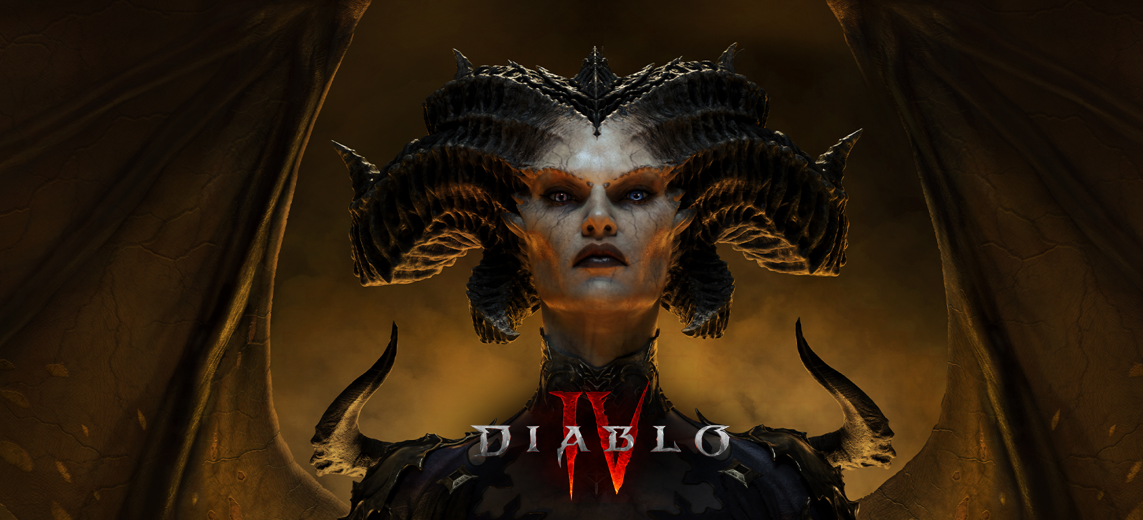October 25, 2023 Update
Wow. Season 2 of Diablo 4 is awesome. They fixed so many things and the game is much more enjoyable now. Additionally, the league mechanic is solid. I’ll be updating the review soon to reflect this.
A complete breakdown of the patch notes can be found here: https://news.blizzard.com/en-us/diablo4/23964909/diablo-iv-patch-notes.
Table of Contents
Diablo 4 Introduction
On May 15, 2012, Blizzard released Diablo 3. It had a lot to live up to given it was the sequel to Diablo 2, one of the best games ever made. Sadly, D3 failed to live up to expectations and had numerous issues at launch tied to connectivity and the abysmal auction house for real money system. D3 was smoothed out over the years, but always had a “fluffy” feel to it compared to other more hardcore ARPGs like Path of Exile.
More than eleven years later, we have one of the most anticipated releases in the industry. Enter Diablo 4.
- Developed by: Blizzard Activision
- Release Date: June 1, 2023 (Windows, Console)
- Version Reviewed: 1.2.1
As gamers, we often forget to realize just how much content we have available to us now. We compare new releases to established games. For example, people try to compare D4 to Path of Exile (which has more than 10 years of development behind it). We’ve become so accustomed to refined products that have been enhanced over the years that when a new game comes out, we often hold it to unreasonable standards far above and beyond what would have been considered just a decade or two ago.
Having said that, I want to be clear. Diablo 4 is hands down the best “initial release” of any ARPG we’ve seen. What Blizzard put together is a work of art. While the game does have issues, the core is solid and akin to the nostalgic releases of many games we loved from the past. The announcement that Diablo 4 is Blizzard’s fastest-selling game ever reaffirms the fact that gamers want a new ARPG, and they believe D4 will deliver.
The reason it’s taken me more than a month to write the review of Diablo 4 is because I’ve been playing it the entire time and having a blast. I’ve played all classes to end-game and tried most of the meta builds. I’ve done all the content in the game except for the Uber Lilith fight.
Before I dive into D4 I want to talk about the absurd behavior of the gaming community. Let’s start with the review bombing on Metacritic. I’m not sure what’s going on, but people have either lost their minds or there is an active campaign to review bomb Diablo 4. I’ve looked through the reasons for the bad ratings and they’re either outright lies or whining from players who don’t want to have to work to progress. It’s quite disheartening seeing so many absurd reviews of this game. On top of that, players are complaining nonstop online about trivial issues with the game and release schedule, including people being critical of the developers for doing nothing wrong. Players are even going so far as saying Seasons shouldn’t require new characters to be created. I’ve never seen this level of crazy for an ARPG release, and it’s obvious many gamers have simply lost their minds. Don’t listen to any of the drama or garbage. Play the game and enjoy it.
What makes Diablo 4 not just a game worth playing, but the best ARPG release in gaming history? Let’s find out!

Content
D4 is a Purchase to Play game. There are three editions available: Standard, Deluxe and Ultimate. Standard is $70 and Ultimate is $100. The difference between Standard and Ultimate consists of in-game visual items (mount, etc.) and the Battle Pass (covered below). If you’re on the fence but want to try, you can purchase the Standard edition and then upgrade it later.
There is no Pay to Win in D4. The developers reaffirmed this numerous times and ensured the community all MTX (Microtransactions) will be solely for things like cosmetics or progress-enhancing systems like the Battle Pass.
D4 will feature regular Seasons, with Season 1 beginning in July of 2023. I really like that they didn’t launch the game with Seasons, because the team wanted to fine-tune the game before they began the season process. This was an excellent call as there have been numerous nerfs and changes to the game since launch.
Each season will feature a purchasable Battle Pass for $25. The pass rewards Emblems, Emotes, Cosmetic Items, Titles, and other MTX. It also accelerates the Favor system, which allows players to unlock Season features at a faster rate. I believe this is a good system because D4 needs to have income in order to host and maintain the online world servers. While it gives people who purchase the game an advantage, it’s only with speed and cosmetics. Players who don’t buy the battle pass will still be able to unlock everything, it will just take more time. More details on the Battle Pass system can be found here.

Character Creation is fairly standard, allowing for the customization of face, body, hair, and accessories. This includes settings the skin tone and eye color. Players can also define makeup, jewelry and tattoos. But the reality is most players who customize the look and feel of their character ultimately select gear that covers up most, if not all, of the body features.
There are five Classes in D4. Barbarian, Druid, Sorcerer, Necromancer and Rogue. Each class has its own unique expertise system. Barbarians have an Arsenal where they can level and select additional weapon modifiers. Druids have spirit boons they unlock and select for their build. Sorcerers have enchantments they can slot to enhance their skills. Necromancers have minion abilities (which can be toggled off to enhance melee and magic), and rogues have specializations ranging from combo points to inner sight.
While one can say all classes are capable of doing all content, including Level 100 Nightmare Dungeons and Uber Lilith, the reality is there are only a handful of builds across the classes that can complete the toughest content in the game. That and probably less than 2% of all players will ever do the content I just mentioned. Additionally, some classes shine and destroy during the leveling process only to teeter off as they enter end-game while others are a dreadful slog to level, only to explode in power at end-game. Many builds revolve around unique items, some of which are very difficult to find. What it really comes down to is D4 offers play styles of all kinds. Players can enjoy melee barbarian, ranged rogue, ice shatter sorcerer, crazy pummeling bear, summoning necromancers, and more. Many players are find progressing slowly and having fun while others want to push to the end-game as quickly and efficiently as possible. The amount of opinions on viable builds for this game is astounding. I’ve rarely seen a game community engaged in such aggressive banter regarding what qualifies as good, best, meta, and such. In the end, it’s all about the build you think is the most fun and enjoyable for your play style. Some builds will give you carpel tunnel due to the nonstop clicking while others let you one-button your way through your victims. Play what you enjoy and try new builds. That’s the real fun of D4, and the game delivers in this area.
There’s no question some of the classes and builds need refinement, adjustment and balancing. But that’s par for the course with any new release of a complex ARPG.
The builds I’ve played so far are: Rend Barb, Whirlwind Barb, Twisting Blades Rogue, Barrage Rogue, Penetrating Shot Rogue, Firewall Sorcerer, Ice Sorcerer, Bone Spear Necro, Summoner Necro, Tornado Druid, Storm Druid and Pulverize Druid. My favorite builds have been Cocaine Bear (Pulverize Druid). It’s tanky, tons of fun with smashing and can handle everything I’ve thrown at it so far. My second favorite is the Firewall Sorcerer. It’s the tankiest sorcerer build with a relaxed play style. It’s one of the fastest leveling builds, but slows down and performs “ok” at end-game. It definitely needs a few adjustments that I hope are addressed in time for Season 1. My third would be Twisting Blades Rogue, which is probably the best all-around build in the game.
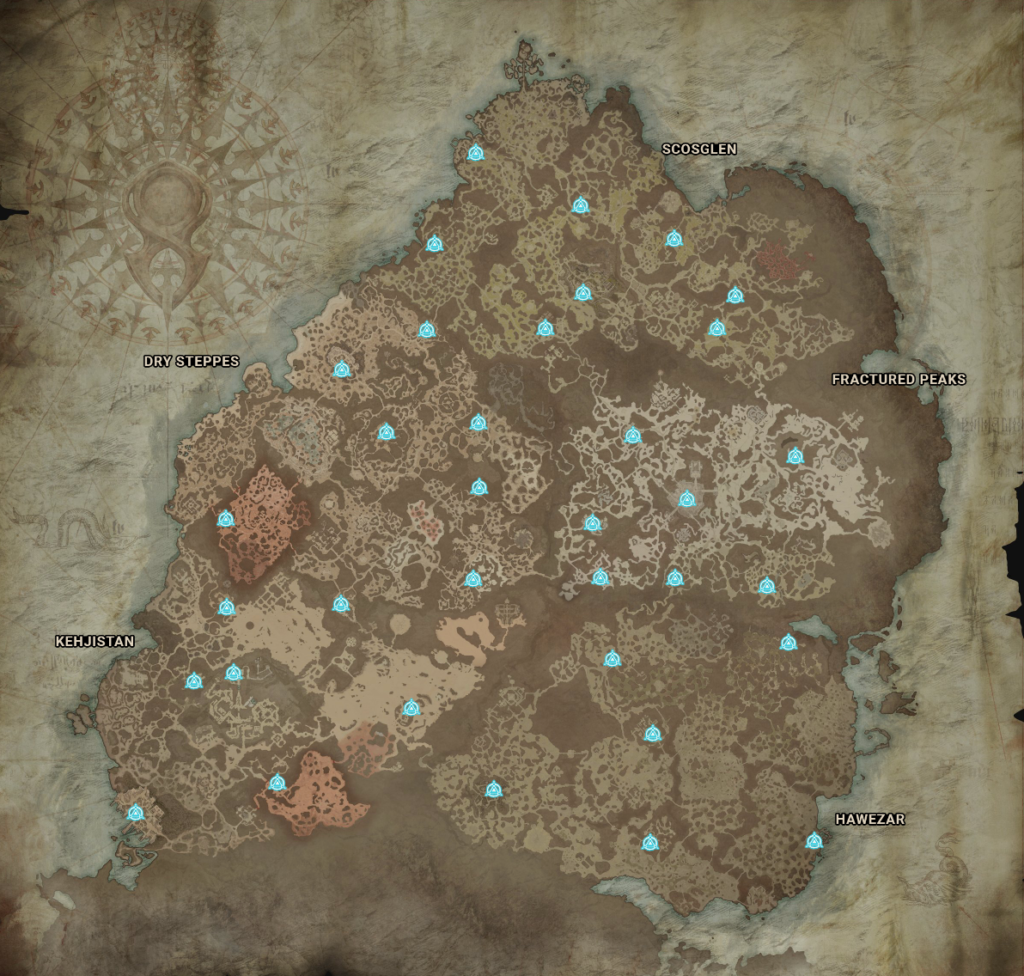
The World of D4 is a continent called Sanctuary, and it’s big. Very big. There are five regions: Fractured Peaks, Scosglen, Dry Steppes, Hawezar, and Kehjistan. The terrain ranges from snowy mountains to dreary swamps and dune-ridden deserts. Surprisingly, there’s no Forest or Jungle, but I’m sure we’ll see that in the future. Each region has a major city, with the main city hub of Sanctuary being Kyovashad. There are also numerous towns and hubs spread throughout the world. Cities and Towns have merchants, crafters, and other services, which are covered in more detail below. The open world has beautifully crafted caves, monster encampments, and features altitude differences where players can run up and down slopes, climb cliffs, and jump over water or crevices.
Like its predecessors, D3 has numerous Shrines located throughout not only the open world, but the dungeons as well. Artillery, Blast Wave, Channeling, Conduit, Greed, and Lethal. Some shrines are also cursed while others have to be rebuilt. There are also Faded Plaque shrines, which have a readable plaque, but then allow the player to execute an emote to receive a buff. For example, an Embolden faded plaque shrine will provide a spirit companion to help fight if the player emotes Cheer in front of it. Some shrines are cursed, and when you try to use them, a 60-second event of monsters attack you. All shrine details can be found here.
To give players an idea of how big the game is, there are:
- 315 Areas
- 121 Event Locations
- 35 Waypoints
- 115 Dungeons
- 135 Cellars
- 160 Altars of Lilith
- 15 Strongholds
- 214 Side Quests
- 21 Unique Elites
There is always something to do, and even the hardcore gamers who have been playing 16+ hours a day since launch are still playing the game. Even though they may have done all dungeons and explored everything in the game, there are always new builds to try and items to find.
Let’s quickly talk about the World Color Theme, which is rather faded yet defined. The team at Blizzard did an excellent job at giving D4 a very unique look and feel. The downside is there aren’t really any vibrant colors aside from certain skills and effects. Most character and armor sets are low tint and contrast. But it all works.
As with most Blizzard games, the cinematics for the main Story & Campaign are fantastic. The voice acting is also top notch. Playing through the story for the first time is a treat, and it paves the way for future expansions. The story is dark, creepy, gory, and ultimately epic. The dialogue of NPCs as you pass through the cities and towns is also very well done. The world is alive, and the player regularly hears talking voices around them depending on their location.
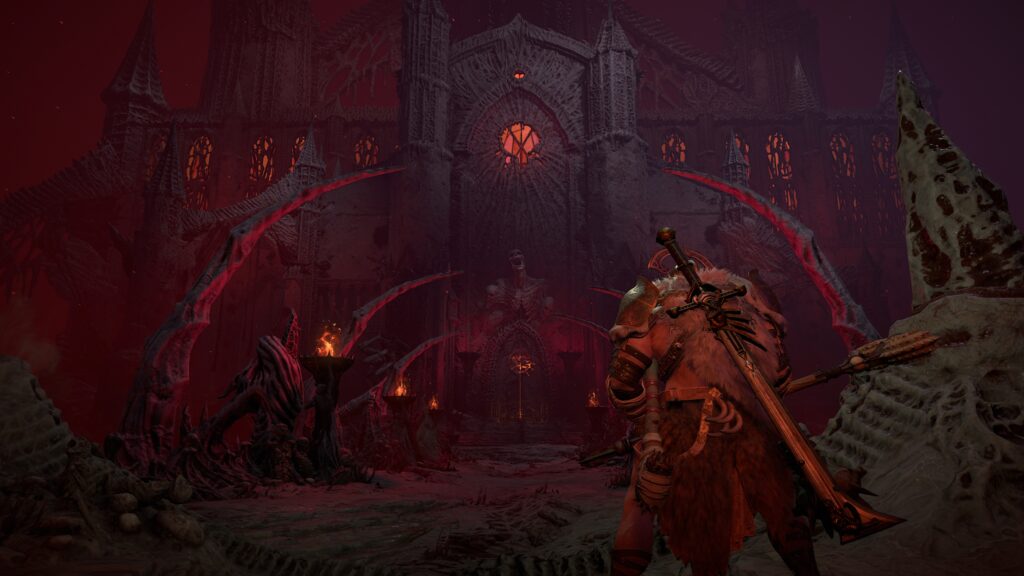
As seen above, the world is littered with hundreds of places to explore and discover. The open world is an instanced shared system that brings 8 people together in specific areas and seamlessly transitions players between areas in the shared space. This seamless joining of other people in the same Tier (covered below) and region is what makes the world feel alive, even when people aren’t playing in group. The open world seamless instancing system also allows for other players to join in Events, Strongholds, Legions and World Bosses.
There are dozens of types of Events a player can encounter ranging from Jar of Souls to rescuing explorers. They generally consist of growing waves of monsters followed by a final boss. Juicy chests often drop at the end, and Events are the best means of acquiring Obols, which are used to chance items.
Strongholds are essentially towns that the player must conquer. Similar to an event, they are more in-depth and dangerous, but once conquered, the player usually unlocks a waypoint, sometime services, and can return to that stronghold anytime without having to fight their way through again. This brings us to Legion Events, which are some of the best XP sources in the game. They’re essentially invasions that require a group of players to defeat, and often take place at Strongholds. If a Legion event takes place at a stronghold the player hasn’t conquered, they cannot participate in the legion.
World Bosses spawn every 6 or so hours, and there are currently three of them: Ashava, Avarice, and the Wandering Death. Depending on the Tier and power of the group at the boss, taking them down can take from one minute to more than ten. World Bosses can drop unique MTX as well as a weekly cache that can have numerous goodies in it. The weekly cache resets every Wednesday.
Cellars are small single room mini dungeons that often have an event to complete.
Next to the open world, Dungeons are the bread and butter of D4 and where players spend the vast majority of their time. Dungeons generally have two or three sections, each with a required act to complete (such as slay all enemies or return stones to the pedestals). They contain shrines, traps, events, and depending on the difficulty level, can be packed with elites. Note that some dungeons are actually outdoors. Most dungeons have a boss at the very end, but some are completed by slaying specific tough enemies.
Capstone Dungeons are used to unlock World Tier III and IV, which is covered below under Mechanics. While completing the Tier III capstone dungeon isn’t that difficult for a well-equipped character, defeating Elias to unlock Tier IV is quite tough.
Nightmare Dungeons provide the toughest end-game progression content and range from Tier 1-100. A Tier 1 NM dungeon has Level 55 monsters. A Tier 100 NM dungeon has level 154 monsters. Given the max level of a character in the game is 100, it’s easy to see how only a fraction of players will ever be able to complete a Tier 100 nightmare dungeon. These dungeons are accessed by using Sigils, which can drop or be crafted at the enchanter. Each nightmare dungeon is for a specific dungeon type and has 5 affixes in World Tier IV. One of the affixes is beneficial to the character and the other 4 are detrimental. An example of a beneficial affix is: player does 15% more physical damage. The first detrimental affix is usually the worst, and can include mechanics such as a storm crystal chasing the player around. The other affixes can include monsters doing additional damage or taking less damage of a specific type. One player put together a list of the best dungeons to run as far as layout goes, and it’s pretty accurate. While early tier Nightmare Dungeons aren’t very difficult, as the player pushes levels, the affixes become very important since certain combinations will ensure death and must be avoided. Players can salvage a sigil to get Sigil Powder, which is what’s used to craft them. In many ways these are the Greater Rift Keys of Diablo 3, but with additional mechanics and modifiers. It’s a challenging and fun mechanic, and can be very rewarding, especially given Nightmare Dungeons are the only way to level Glyphs. At this time, Nightmare Dungeons are the most difficult content in the game next to Uber Lilith.

The Tree of Whispers is a focused progression system that unlocks after completing the Campaign (and is available in Tier I). It marks specific dungeons and events in the open world. Completing these requirements awards points, and they can be turned in for caches, which can include legendary and even unique items. What I like about this mechanic is it has the player exploring places they may not have visited and it allows selective cache rewards for the types of items one is looking for. It’s excellent for leveling early and mid-game, and is often the mechanic of choice for alternative characters on accounts that have already completed everything. The selected goals for this system reset every 90 minutes.
Helltides are an open-world event that takes over an entire zone, raises the level of the monsters, and allows players to gather Aberrant Cinders which they can use to unlock chests scattered throughout the affected zone. They last roughly one hour. One of the most important resources, Forgotten Souls, drop from the Helltide chests. These are used to reroll (Enchant) affixes on items. The best chests in the game are also found during these events, the Mysterious Chests. They often drop up to 4 legendary weapons as well as elixirs. There are also other resources spread throughout the zone, such as a Screaming Hell Vein or Fiend Rose, which can also provide Forgotten Souls. Helltides generally take place every two hours and are only available in World Tier III and above. They are also the best mechanic for players to farm after entering a new difficulty level because there are so many other people in the area who can help out. Dying in a helltide will cause the character to lose half of the cinders they’ve gathered.
There is no Auction House! This is a good thing. While players can trade (covered below), the game focuses more on characters finding their own gear and not relying on the luck of others to make a build complete.
D4 has voluntary PvP zones, which are some of the best places to farm mobs in the open world. PvP can actually be a lot of fun depending on your build and the builds of enemy players. I cover the PvP system in more detail below under Mechanics.
D4 is the first of the series to provide for the Gathering of resources from plants and minerals spread throughout the world. These resources are required to upgrade items and craft potions.
Next we have Mounts, which make all the difference in traveling throughout the world. While all mounts are currently horses, players can customize the look and feel of thier mounts with MTX found both in-game and purchased in the D4 shop. While the core functionality of mounts is solid, there’s a lot of wonky behavior with them getting stuck on objects and stuttering between zone transitions. The good news is a player can summon their mount from anywhere (except in a dungeon/enclosed space) and use it to quickly and efficiently move around the world.
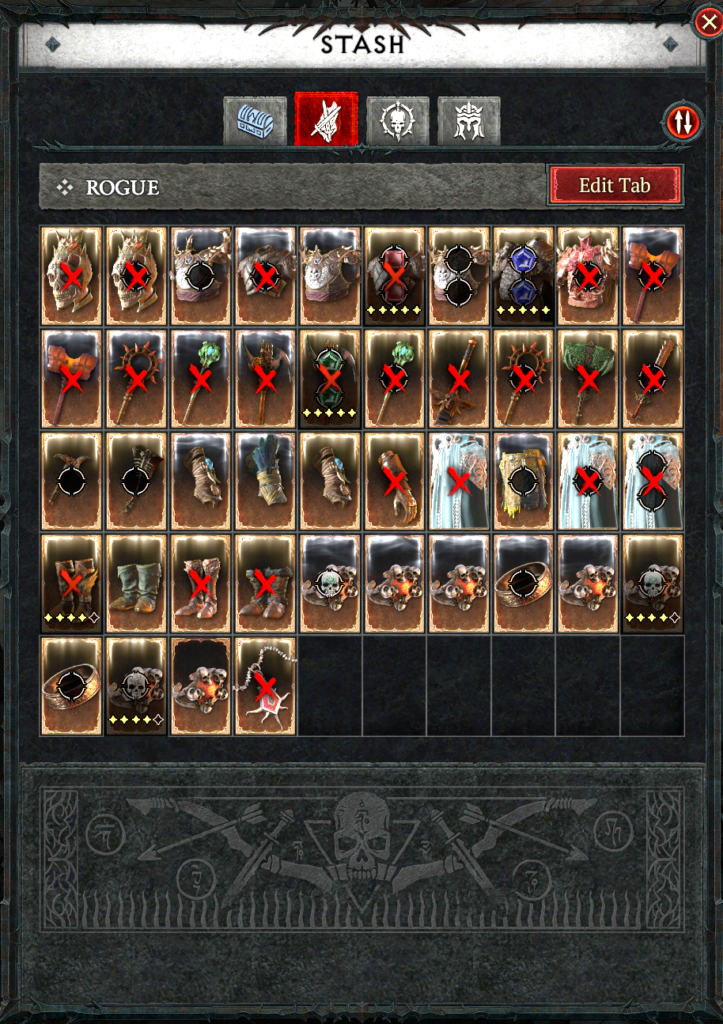
Now it’s time to talk about Inventory in D4. Each character has four tabs: Equipment, Consumables, Quest, and Aspects. Each tab can hold 33 items. While this is enough space for the character, the problem is the Stash. It only allows up to 4 tabs with each tab holding 50 items. For the entire account. This means a player only has a 200 item storage capacity for all uniques. gems, items, and aspects. It’s ridiculous, and one of the most complained about aspects of the game. The Stash does have an Overflow option, which is nice. Whenever you are in a dungeon or in the world and unique or MTX item drops and you don’t see it and/or forget to pick it up, the game will automatically put it in the overflow queue of your Stash.
One nice feature of the Stash is the game will automatically pick up any Legendary or Unique items the character leaves on the ground in the world or dungeon they may have overlooked. So if you want to race through a dungeon and leave the legendary drops behind you, this system picks them up as long as the queue doesn’t exceed 10 items. If the character has one or more items in the stash queue, an exclamation point appears by the stash symbol in the base.
Each Skill in the game has a base type and tags associated with it, and if its an action skill, it also features a damage type. For example, the Necromancer Bone Storm skill is of the Ultimate category and also tagged as Darkness and Bone while having the damage type Shadow by default. Players can change the subcategories and damage types of skills through item modifiers, which allows for an interesting combination of builds.
As with any ARPG, Items are the bread and butter of character development and progression. Helm, Chest, Pants, Boots, Weapon (2H or 1H and Offhand), Rings, and Amulet. Every item has a defined Item Level, of which there are six Tiers. These levels range from 1-850, with items above 800 being the most powerful in the game. Item Level also defines the tier of roll value for the affixes, so for example a 250 Item Level Ring may only be able to roll up to 3% Crit Chance, but the same item as level 800 may be able to roll up to 12%. Common and Magic items pretty much exist for salvaging. Rare items always roll with at least 3 affixes, but can have a max of 4. The hunt for the best items in the game generally revolves around Rare items because the player can easily convert them to legendary items by applying an Aspect. To confirm, a Legendary item is just a rare item that’s had an aspect applied to it.
There are also many Unique items in the game, and many of them are build defining. While the majority of uniques are random drops, players can target farm types of item drops from specific monster types, which increases the chance of a dropped unique to be that particular item type. For example, if a player wants to farm for a Tempest Roar, Cultists and Cannibals have the highest helm drop rate. Here’s a link to a tool that helps players target farm uniques.
Unfortunately, there is no Loadout system for D4. Many players have requested this feature, and I wouldn’t be surprised to see it added in a future release.
Before we dive into the specific crafting systems, there are four different NPCs available that offer crafting services:
- The Alchemist (Craft Potions and Elixirs)
- The Blacksmith (Salvage and Upgrade Weapons/Armor)
- The Jeweler (Socket, Craft Gems, and Upgrade Jewelry)
- The Occultist (Imprint Aspect, Extract Aspect, Craft/Salvage Sigil, Enchant Item)
Build definition in D4 revolves around Aspects, which are the custom modifiers of items with specific mechanics, adjustments and bonuses the player can either find or craft. There are five categories of Aspects: Offensive, Defensive, Resource, Utility and Mobility. At this time there are a total of 222 aspects in the game, and given the unique nature of each aspect, this gives the player an idea of the depth of build diversity one can put together. There are aspects considered to be “standard bread and butter” for nearly every build, like Disobedience or Edgemaster. Players can also Extract Aspects from dropped Legendary items. This is how players hunt for the best aspects. While many aspects are made available by completing dungeons, they always have the lowest rolls, so in order to get the best rolls for an aspect, they must be farmed and extracted. For a complete list of aspects and what they do you can review them here.
Players can Upgrade items up to 5 levels in order to increase the values of the Affixes on the item. This technique can be used to “bump” the item into the next tier of affix rolls. For example, the player can find an item that’s Item Level 720, which is Tier 5. By enchanting it to +5, the item now has +25 to its item level, and has been bumped to Tier 6 because it’s higher than 720.
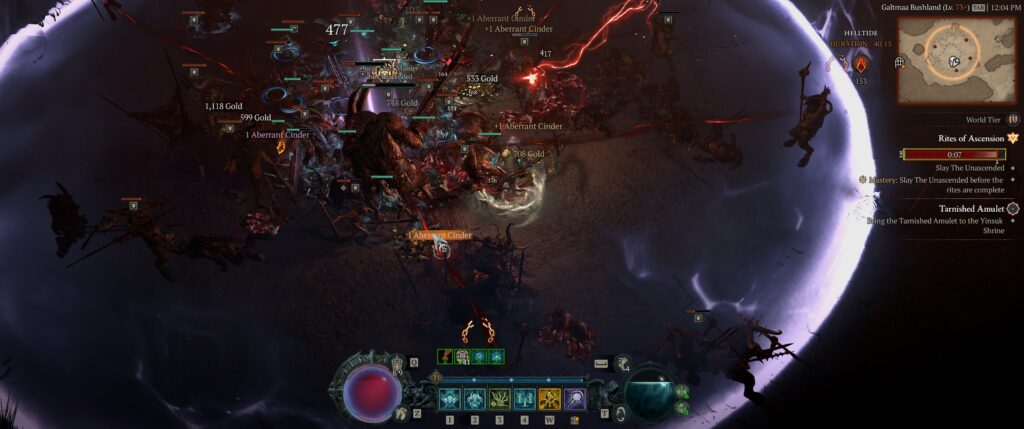
The Occultist provides the ability to Enchant an item, which is similar to D3. It allows the players to choose one Affix to reroll into another. Once chosen, that affix is locked.
Applying Aspects, Enchanting, Upgrading, Socketing, and Extracting Aspects all cost Material Resources. This is where Resource Farming and Salvaging comes in. As players adventure throughout the world, they will come across Ore Veins and Plants which they can click on to get materials. Killing monsters also causes resources to drop. There are currently five categories of resources: Plants, Ore, Skins, Monster Parts, and Salvage. The reality is just playing the game really awards most of what a character will need to progress, however, someof the most sought after items for end-game crafting are Forgotten Souls, which drop only in Helltides.
One feature that is very similar to Diablo 3 is the use of Gems. In D4 we have: Emerald, Topaz, Amethyst, Ruby, Diamond, Sapphire, and Skull. Each gem provides a bonus based on the type of item it’s applied to. Sadly, the majority of builds all use the same Gems and there’s not much diversity. As with D3, gems are available in multiple tiers (e.g. Crude Ruby or Royal Ruby) and can be crafted at the Jeweler. Players can Socket Gems in their Helm, Chest, Pants, Weapon, and Jewelry.
The game needs an item filter. Badly. When a character is in end-game and upgrades are difficult to find, D4 forces the player to slog through each drop and visually review it to see if the item has any of the affixes required by the build. This combined with searching for specific aspects makes item review management at end-game quite tedious. All of this would easily be fixed with an item filter system where the player could define what aspects and affixes they are looking for. I hope we get this in the near future.
Even with the lack of a filter, the item and gearing system in D4 is solid both during leveling and even at end-game. Upgrading your weapon, finding a better aspect, or a new chestpiece with every affix you’ve been looking for; it’s rewarding and fun.
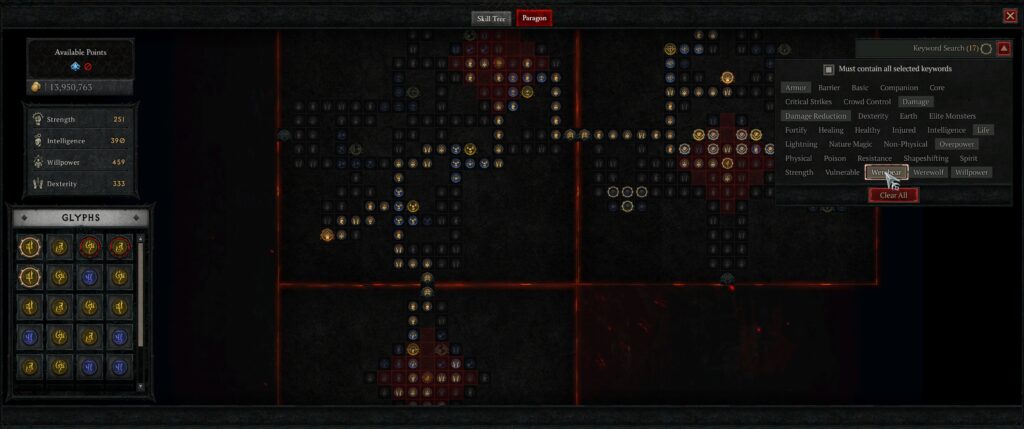
The Paragon System is an end-game character and build refinement board the player can snap together to create unique build enhancements. This mechanic unlocks at level 50 and provides 5 points per level, awarding points as the character progresses toward the next level. A complete level 100 board will have 225 points to spend. The system includes connecting and rotating boards to create more efficient pathways and socketing Glyphs for added power. Each paragon board has a legendary node, numerous rare nodes, and a single socket node. Players can socket any glyph they want in the board, and swap it out anytime. Once the Paragon board is unlocked at Level 50, Glyphs will start to randomly drop. It’s been my experience that characters will collect all of their Glyphs by around level 70. Glyphs can be leveled up by running and completing Nightmare Dungeons. The level of the dungeon determines the speed at which a Glyph can be upgraded. When a Glyph hits Level 15, it’s coverage area extends by one point, which allows for some strategic planning and swapping of Glyphs as they are leveled. The max level of a Glyph is currently 21.
One defect of the paragon system has is you can’t tell what board has been attached once selected. Thank goodness Blizzard added a Refund All button to the Paragon board with Season 2. While the Main Campaign must be played through at least once, there are more than 220 side Quests available in the world that provide numerous rewards. A complete list of Side Quests and their rewards can be found here.
Ultimately, the paragon system is solid. It allows for a wide variety of end-game builds, and two characters of the exact same class and skill setup can function quite differently at end-game solely based on the Paragon board. Some people push for max damage while others (usually hardcore) push for defense.
D4 features Region Progress which is based on acquiring Renown. This is done by exploring new locations, securing waypoints, conquering strongholds, completing side quests, dungeons, and finding Altars of Lilith. Completing five steps in each region (5 in total) rewards skill points, potion capacity, max Obols and Paragon Points. The reason this is so important is because the rewards are account-wide. This means if one character completes and unlocks all rewards, all other characters on the account have access to those rewards. This can make a huge difference as starting characters can have 10 skill points at level 1, and an extra 20 Paragon points once they hit level 50. Players refer to this as The Renown Grind.
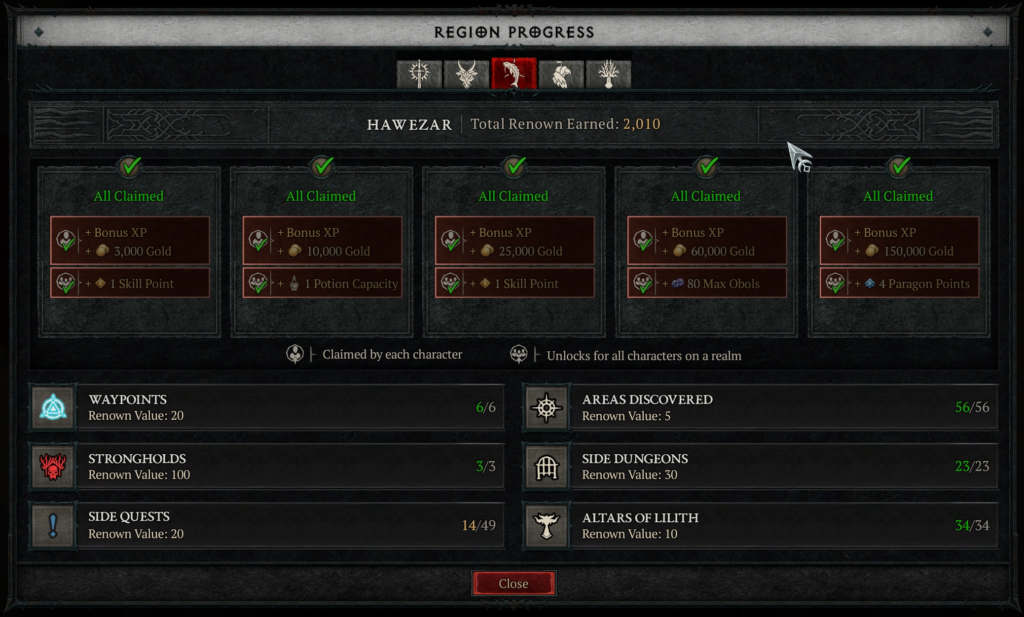
Blizzard dropped the need to re-grind Renown with Season 2. Once it’s done, renown will always be complete for future seasons.
There are narrated missives spread throughout the world, often in the form of Journal drops in Dungeons. The voice acting is good, and some of the stories are quite interesting.
The variety of Monsters is very good, but more than that, their behavior, animations, sound FX and overall nature of the game design behind the creatures is solid. Goatmen, Succubus, Demons, Werewolves, Spiders, Knights, Bandits, Bats, Snakes, Scorpions, Naga… you name it. Many of the critters we all know and love from Diablo 1, 2 and 3, and a bunch of new ones. But the real fun comes into play with Elites, which can have specific Affixes on them. Much like D3 with the cold explosions and exploding flames, D4 has refined this system and it’s much smoother than it was with the previous game. Elite Affixes are broken into six categories: Cold, Fire, Lightning, Poison, Shadow and Utility. While the beginning of the game introduces the players to these modifiers slowly and they aren’t very dangerous, by the time a character reaches Tier IV, many of these Affixes are deadly and can one-shot a character. Fire Explosion, Teleporter, Terrifying (Fear), and the most hated, Suppressor, are just a few fun enhancements Elites bring to the battle to spice things up. A complete list of Elite Affixes can be found here.
There are also unique Elite (or “Rare”) spawns throughout the world. These nasty critters drop unique rare items, which can be the most powerful in the game and able to roll well over 800 in item level. The items they drop are very specific, but can be best in slot (BiS) for a build. Here’s a complete list of all the rare spawns and the items they drop.
Capstone Dungeons are the gateway to unlocking higher tiers, and there are unique bosses with their own mechanics. The first Capstone (Cathedral of Light), generally completed at level 50, unlocks Tier III. There are two sets of bosses; the first is The High Council (4 in total) and the final boss is The Curator. It’s not that difficult for a well-equipped character. The next Capstone (Fallen Temple) is required to enter Tier IV and is much more difficult. Fallen Temple provides two paths to the boss. Both paths curse the player the longer they go without killing anything. This mechanic entices players to kill everything they see on their way to the boss. The final boss is Elias, and he’s very tough. I found the best level to do Elias was 62.
The only “surprise” boss in the game is The Butcher, which can randomly appear in a dungeon, and he’s very tough. He will always drop a legendary item, and can also drop his unique axe.
The in-game Tutorial is good for new players and does a fair job of explaining the mechanics.
D4 has more than 400 Challenges the player can complete, each rewarding two different titles. These Titles can be set on a character’s profile to define a tag that everyone else can see, like “Hungry Monster” or “Old Goat”. The title system is actually a lot of fun, and many players choose titles that reflect their build and gameplay.
The Codex of Power is a collection of Aspects the player unlocks by completing dungeons throughout the world. Once unlocked, they are available for all characters on the account. This system provides the first level of access to item enhancement. For example, a Twisting Blades rogue wants to unlock Bladedancer’s Aspect as soon as possible. This is done by completing the Jalal’s Vigil dungeon in Scosglen. Once complete, the aspect is permanently unlocked on the account for all characters and can be used at the enchanter. One of the most powerful aspects is Disobedience, used by nearly all classes and unlocked in the early game by completing the Halls of the Damned in Kehjistan.
Players can change the appearance of their character and attire at the Wardrobe station in a main city. This allows for the change of character features, selection of custom skins for weapons, armor and utility (backpack). Skins are unlocked by finding base items in the game and salvaging them. This means if a character wants the look from a unique item they aren’t using, they need to salvage that item to learn its appearance setting. Ultimately, the visual customization is a lot of fun and it’s very rare to see two characters who look alike.
I hope they add SSF (Solo Self Found) to D4. Mainly because solo players cannot compete (at all) with people who run in groups due to the XP bonus.
D4 will feature Seasons, the first of which starts in July. I believe it was a very good decision for Blizzard to not launch the game with Season 1. This gave the developers time to balance the game and fix the many exploits and broken mechanics players were quick to find. Even now, one month later, the game is in a much better state than it was at launch.
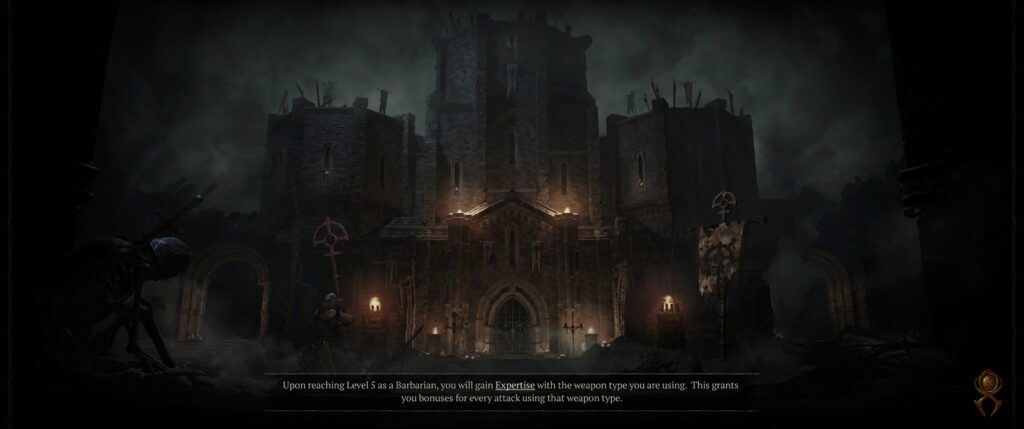
Gameplay & Mechanics
Before we dive into the mechanics of D4, I want to preface by saying a key missing feature from multiple systems is that of a search ability. Blizzard did add Search and Filter to the Stash system with Season 2, which is a step in the right direction, but the Paragon board, world map, and Codex of Power are still missing proper search features.
D4 can only be played Online. The reason I mention this is because many people have requested an offline version. I don’t think it’s necessary or it’s going to happen. If somebody is in a position to play D4 without internet, they should probably not be playing a game.
The gameplay experience revolves around the selected World Tier, which defines the difficulty of monsters and the items that can drop. Currently, there are four tiers available, with Tier I and II being selectable at the start. Tier III and IV are unlocked through completing specific Capstone dungeons. The most important part of moving through the World Tier structure is access to the new Sacred (Tier III) and Ancestral (Tier IV) items.
The entire world uses a Level Scaling system where regions scale up, but not down. This is a great design because a character can adventure through any part of the beautiful and huge open world to take a break from dungeon running and simply farm groups of enemies they come across. And much like dungeons, especially in World Tier IV, it’s not uncommon to come across groups of elites.
It wouldn’t be a Diablo game if there weren’t Treasure Goblins. Sadly, there’s no secret goblin realm, and the reality is the loot from the goblins isn’t anything special, although I wouldn’t be surprised if there are rare MTX they can drop, but I haven’t seen any.
The max Character Level is 100, and very few players will ever achieve this goal (I’m guessing less than 2% of the total player base). Even if a character reaches max level, they can still farm gear and raise the level of their Glyphs (which many do) in order to take on and complete the final boss fight in the game, Uber Lilith. A character generally wants to be level 50 before moving to World Tier III, and Level 62 before World Tier IV. It’s important to mention the experience bonus for monsters stops at 25% at 3 levels higher than character. This means a character will never get more experience from monsters 4+ levels higher than they would with just 3. For this reason, it makes sense to target farm Nightmare Dungeons just 3 levels higher unless the player is running a very capable build and simply wants to farm Glyph Experience (which is higher based on the level of the Nightmare Dungeon). Being in a party provides an additional 15% experience, and having nearby players (for events, etc.) provides another 5%. And finally, the player can activate another 5% experience bonus by using Elixirs.

Stats in D4 revolve around the base values of: Strength (Armor), Intelligence (Resource Generation & Resistance), Willpower (Skill Damage, Healing, Overpower) and Dexterity (Critical Strike and Dodge Chance). The three core combat stats are Attack Power, Armor and Life. There are also four key subcategories. Offensive encapsulates things liked Overpower Damage, Critical Chance, Damage with Poison, etc. Offensive, Defensive, Utility, PvP.
There are six core Types of Damage in D4. They are: Physical, Fire, Lightning, Cold, Poison, and Shadow. The core damage types have sub-damage types, such as Bleed for Physical, Shock for Lightning and Freeze for Cold. There are also Damage Bonuses, such as additional damage to Elites, Close, Distant, Healthy, Slowed, etc. There are three kinds of DoT damage: Burning, Bleeding and Poisoning. Only Direct Damage can Critically Strike. DoTs cannot. There are four states in combat: Stunned, Slowed, Controlled, and Fortified. Vulnerable enemies take 20% more damage from all sources. Damage from Critical Strikes is defined by the Critical Strike Damage value. Overpower has a base 3% chance, and it’s not a multiplier. Overpower damage scales based on life, fortified life, and overpower damage stat. Maxroll has a good overview of the damage types and how they work here.
Lucky Hit is a new mechanic that determines how often a specific attack type can trigger. Items offer an added percent chance to Lucky hit, but nothing will happen unless the player equips items that actually do something on a lucky hit. Effects include stunning, causing other actions to trigger (such as a meteor strike), and even executing injured non-elite monsters.
There are numerous buffs and debuffs in the game. The most common buff is that of Fortified, which causes the character to take 10% reduced damage, and is generally triggered when a player’s life exceeds the base value. Healthy represents those with 80% or more life, and Injured is less than 35% of life. There are Immunity mechanics, but most of them apply to bosses.
All bosses are immune to the direct affects of any type of Crowd Control. Instead, there is a mechanic called Stagger, which is indicated by a bar under the name of the Boss. When it fills, the boss becomes staggered and incapacitated for a short period of time.
Characters can become Unstoppable by using specific skills (such as Teleport for a Sorcerer). This mechanic removes and prevents all forms of crowd control. This includes freeze, traps and other slowing affects. All classes except for Necromancer have skills that make them unstoppable. Vulnerable targets take 20% extra damage.
While all characters have Life, each class has a different Resource pool (e.g. Necromancer has essence and Druid has Spirit). I want to be up front and state that resource management in D4 is my least favorite thing. Players often spend so much time during the leveling process managing low and empty resources that it does impact the fun factor of the game. Not to say the game is bad, but I think the way resources are handled is very poor. Nearly every build struggles between 1-75 with resources, and the player is forced to use resource generating attacks all the time.
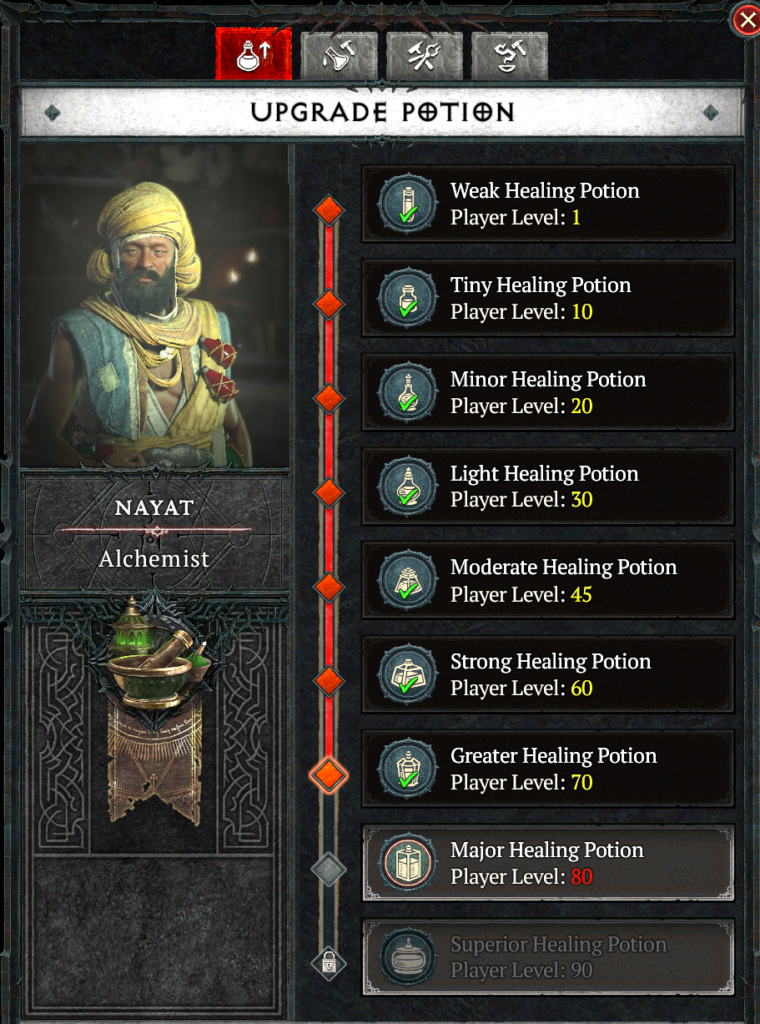
Potions are a very important part of the game and can be upgraded based on character level. D4 also features Elixirs. They last 30 minutes, provide 5% additional experience along with numerous choices of additional buffs, such as resistances or damage. Players can craft Incense. They last 20 minutes and are designed for an entire party, but don’t offer any experience buff.
When a character dies, their items lose durability and must be Repaired if the durability gets too low or to 0. This mechanic exists solely to control players from doing content that’s far too difficult for them and really for no other reason as repair costs are trivial.
I want to make a comment about Pet classes, namely the Necromancer. At this time there is no ability to direct pets to attack a specific target, and this is quite a problem. While a recent patch did make it so cursed enemies will be targeted, this still doesn’t resolve the issue because curse hits a fairly large area, and if there’s one elite in particular you want your minions to focus on while there’s other monsters around, it simply doesn’t work. As such, suppressor elites can completely destroy a minion build’s ability to function. Blizzard needs to address this serious problem.
The Combat of D4 is smooth, responsive, and fun. I love the way enemies shatter into pieces, turn to ash while burned, or explode in a gory mess when obliterated. In playing every class and multiple builds, fighting monsters is always a great experience. The only time I encountered issues was when I had latency, probably related to my ISP.
The Game Map and Minimap work very well, showing icons for events, dungeons, waypoints, and other special locations. Pinning the map draws a line for the player to follow on long trips, and it works very well (but sometimes has issues). It’s also easy to see monsters as red dots (for events and such), and you can also easily distinguish where your party members are.
The Monster AI is good; enough to keep players on their toes with charges, teleports, casting of spells and basic combat interaction.
The Hotbar allows for 6 skills to be slotted. D4 also has a Wheel Selection interface that can be selected by pressing E. This is a quick select system that allows players to use emotes, consumables, emotes, potions, and game actions such as leave dungeon or open trade with another player.
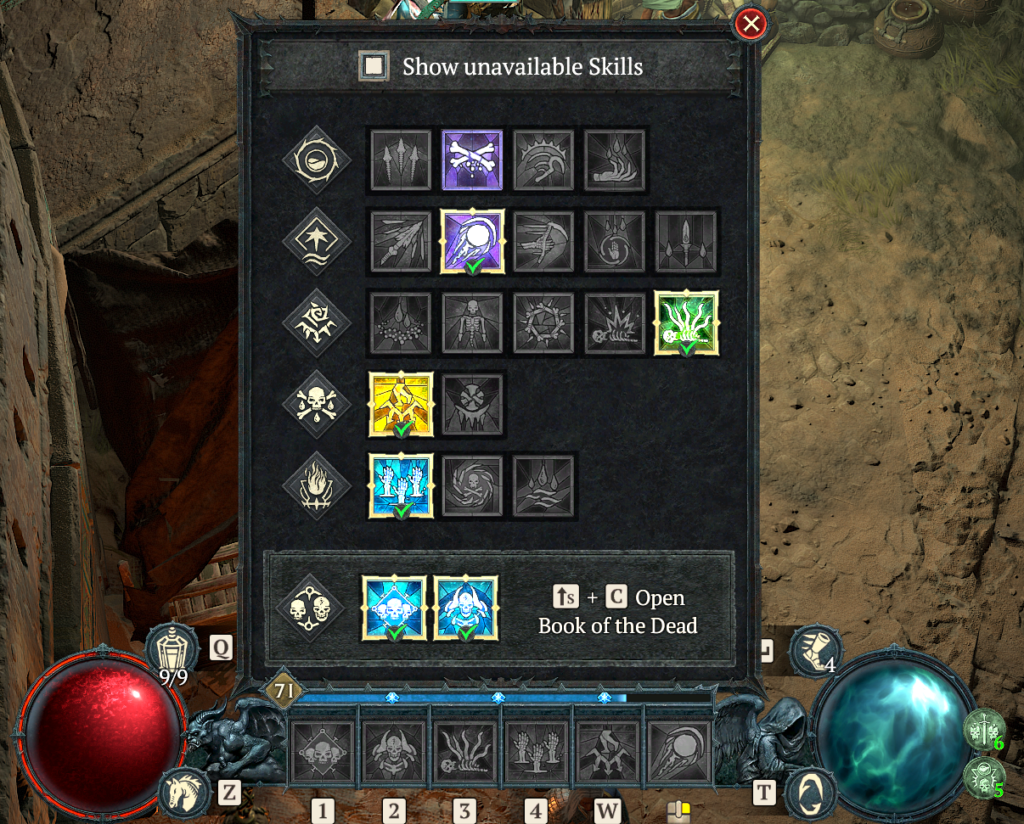
Travel throughout Sanctuary is either on foot, by Mount or portal. Horses are hands down the best method of going to places that don’t have a waypoint, but as the player traverses the shared online system, the mount often gets “sticky” and can be a bit cumbersome to use. It often also gets stuck trying to jump across locations, requiring the player to dismount.
Death isn’t really a big deal in Softcore because it’s more of a control mechanic for Nightmare Dungeons (which only allow a certain number of deaths before the character is kicked from the dungeon) or to prevent players from running content they aren’t ready for. Every time a player dies, their equipment loses 10% durability, so if a player keeps trying to kill a boss they aren’t ready for, after 10 deaths their equipment will be broken and they’ll have to return to town to repair.
And finally, we have the PvP system. It’s actually a lot of fun. Players can go into the open PvP areas called Fields of Hatred (there’s two of them in Sanctuary) where the mob density is crazy (and can be very good for farming). Players must flag PvP in order to become hostile. Once hostile, they can attack anyone (including those who are not flagged). This allows non-flagged people to play together co-operatively. If you are killed in the fields, you only lose your seeds. There’s no durability or XP loss. Seeds act like Obols and as mentioned, must be refined to be spent for acquiring items. If a player wants, they can hang out and level up solely in the PvP area.
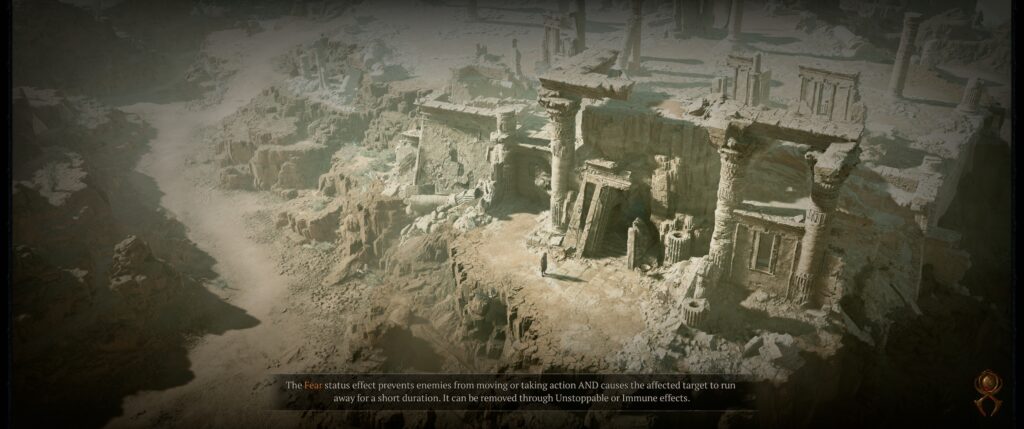
Economy
While there is a large volume of materials for crafting and enchanting items, there’s only three resources that are used for direct spending. Gold is the most common, which drops throughout the world and can be acquired by selling items at the vendor. Obols are acquired from chests, most commonly through events. Red Dust is the PvP currency that can be used to purchase PvP specific elixirs and items. Acquiring Red Dust is a bit of a process as the player must go to an Altar of Extraction in a PvP zone, which opens them up to being killed. If a player is killed while extracting, they drop all of their shards of hatred, so the extractors are hotbeds of combat.
Gold is very important, and players at end-game can quickly find themselves running out due to enchantment re-rolls if they don’t manage it properly.
I want to talk about MTX Shop. It’s pretty lame. In my opinion, Blizzard made a big mistake with the cosmetics. PoE has shown us people want companions, glowing and visually impressive things to purchase and show off. The current cosmetics don’t offer any of that. While some of them look cool, the reality is none of them really “pop”. I hope this changes because as it stands, I have no incentive to purchase anything currently in the store.
Community
As mentioned, D4 is an online only shard-based world game. At any given time, millions of people are playing, and the way the server system handles this is to assign players shared server shards based on the zone. When outside of a large city, the game appears to match up to 8 players to the same zone. But when in a large city, the number is greater. Because of the volume of players, it’s highly unlikely you will see the same player multiple times in the open world once you log out and back in. The game does appear to share zone transitioning well though, allowing you to see the same players over a period of time who are staying in the same area. The good news is it’s very easy to group with random people, communicate, and add them as friends. Since D4 mixes console players with PC players, those on console are generally limited to the emote communication method. Ultimately, events are the most common method of meeting people. Although many people do hang out in town near the waypoint and often strike up conversations.
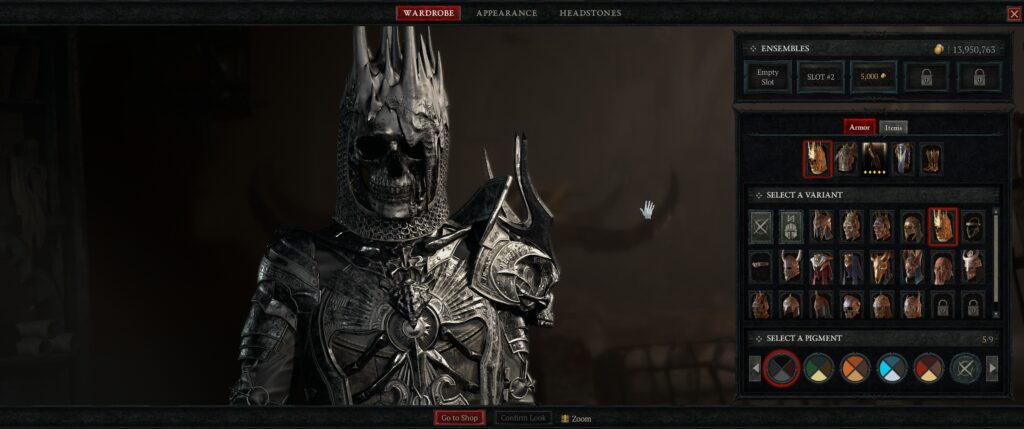
Players can form a Party of 4 up to people. Even in a party, the dropped loot is always specific to the player. Being in a party provides up to 15% bonus experience, and also allows for party members to receive experience from others in the same instance. Many people power level this way – they create a new character and one of their high level friends takes them into a high level dungeon and clears it, which provides experience to the new character standing safely at the entrance. Party members also share buffs, which can make a huge impact on speed, survival and damage.
Party XP bonus is way overtuned. That’s how people made it to level 100 in less than 48 hours with a new season. Solo players cannot compete with party players, and there’s currently no way to differentiate people who played solo vs. party because there is no SSF mode. I’m not sure if Blizzard will make a ladder available with Season 1, but they need to address giving credit to people who accomplish end-game goals solo vs. those who get power leveled and play in a group.
Players can Trade Common, Magic, and Rare items, but not Legendary, Unique or Enchanted items. Gold, Gems and Elixirs can also be traded. These restrictions make it very clear the developers want players to find their own best in slot unique or legendary items, but it also keeps the door open to giving and/or selling amazing Rare items.
While D4 allows for the creation of a Clan, complete with custom banner, member ranks and chat channel, there aren’t any other features beyond the core structure. There’s no clan stash or any additional mechanics. Ultimately, a Clan is really just for chatting with friends in a group environment and having challenges announced to friends.
D4 supports custom MTX Twitch Drops for those who watch live streams. Right now, Blizzard is awarding weapon skins and mount attachments every week for people who watch specific streamers for a total of six hours.
The game has numerous Emotes available through the popup E wheel, which allow players to thank each other, say hello and more. The Chat system is very simplistic, only supporting local, clan and party. There is no global chat.
There is No Mail system in the game.
Technical
D4 was released simultaneously on both Console and PC. As such, the technical base of the game is cross-platform in nature, which means a simplified UI that works on both PC and Console.
The Server Infrastructure is shared and fragmented, seamlessly blending players together in the open world as they move between regions, and creating instances for dungeons. The tech behind this system works well, but there are still a few hiccups to work out as some transitions create a mild rubber-band effect while running through the world on horse. Overall, the game latency is solid, and the only issue I encountered that consistently had high latency was in the Fields of Misery.
By default, D4 has Crossplay enabled. This means players will encounter all platforms in the open world, allowing for PC and Console users to play together. Disabling this feature will cause the game to connect with server shards specific to the platform of the client.
Graphics in D4 are absolutely beautiful, especially in high resolution and with HDR. It’s hands down the best looking ARPG out there. The color palette mixed with the particle effects is fantastic. The game also has day and night cycles complete with rain and snow.

The User Interface is well-designed and rather simplified, which in my opinion is a good thing. As mentioned, the lack of search features is the biggest flaw, and the reality is if this game wasn’t designed to be both Console and PC at launch, I’m confident D4 would have the missing search features. But the reality is console players don’t have a keyboard, so Blizzard decided PC players didn’t need the feature either. It was a very bad decision.
One of the most important things to bring a world to life next to the visuals are the Sound FX, and D4 did a fantastic job. The combined sounds of environment, combat, skill execution, monster sounds, special FX, exploding and shattering bodies, and more all blend together beautifully.
While the Music isn’t quite as nostalgic and defining as it was from D1 and D2, it’s still very good. The scores that accompany the storyline are epic, and the variable music as the player adventures throughout the world and into the dungeons fit the theme and ambience perfectly.
While there are Bugs, the overall launch of D3 went very well given the volume of players. However, even 3 weeks after launch I had trouble logging in (Unable to find a valid license for Diablo IV). Last Sunday, I was unable to log in for hours. I did experience occasional crashes the first two weeks, but they don’t seem to happen anymore. Launch was fairly smooth although the second day there was an hour queue. Crashing in a Nightmare dungeon resulted in losing the dungeon run, which was frustrating, but those issues seem resolved now. I haven’t encountered any serious bugs since they released the 1.0.3 patch except for the latency issue in Fields of Hatred.
There’s definitely technical server issues with the PvP zones. I would be playing the game doing Nightmare dungeons, Helltides and other generic areas at a 50ms ping, and the second I entered the Fields of Hatred, my ping would jump between 80ms-900ms. Others encounter this issue as well, so it appears to be some sort of server issue that Blizzard needs to address.

End Game
The End-game process begins at Tier 4, and in many regards, that’s where the real game is. Ancestral equipment begins to drop and players start really building out their paragon. This is also the time where a character begins to push Nightmare Dungeons, which is required for leveling Glyphs. The leveling process really slows down after 80 for solo players, and many people choose to run a combination of high XP dungeons, Nightmare Dungeons, and Helltides. Below is a list of the things players can do once they enter Tier IV end-game. Note this is assuming a player has completed the account-wide Renown grind, which provides max Obols, Skill Points, and Paragon point awards.
- Maxing Level
- Maxing Gear
- Maxing Glyphs (Level 21)
- Pushing Nightmare Dungeons (Max 100)
- Defeat Uber Lilith
- PvP
- Try new builds
- Play new Seasons
The game has been out for a month for those who were in early access and I see tons of people still on their first character with a level in the 80’s. The reality is only 10+ hour a day players will have reached 100 by now, and the majority of players are still having fun, growing their character and trying new builds.
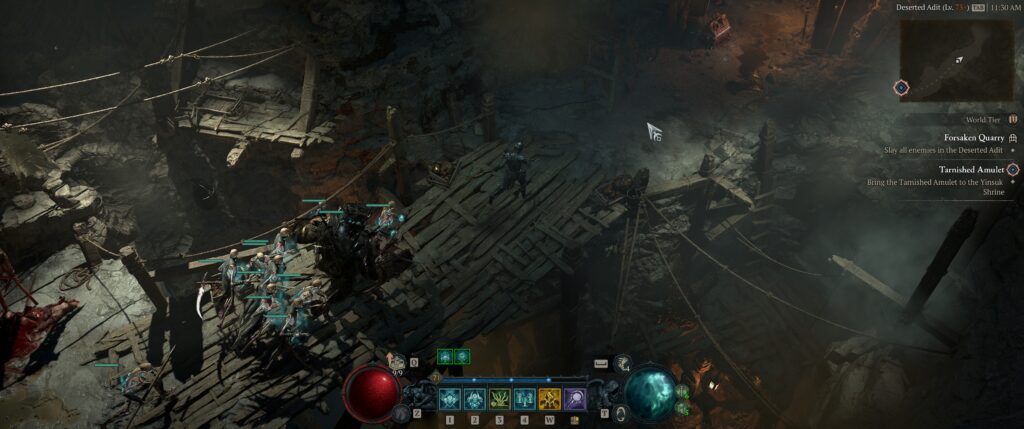
Conclusion
Diablo 4 is an amazing game. It has more content and features than any previous initial release of an ARPG. Each class has numerous builds that work great and while there are definitely some adjustments that need to be made relative to builds that are considered S-Tier, players can enjoy plenty of A-Tier and even B-Tier builds. The reality is most players never get beyond Nightmare Level 50 or Level 85 on their builds because either they have limited time or want to try something different. Sanctuary is a dark, beautiful and fun world to explore with multiple characters. Combat is smooth and engaging, and the game has excellent potential with future seasons, patches and expansions. The campaign, story and videos are top quality and worth the initial playthrough. The core design and mechanics of D4 are solid. And in the end, that’s what really matters.
As I mentioned in the introduction, the online gaming community revolving around D4 has gone crazy. There are so many people playing and content creators are doing everything they can to get views on their videos. I’ve never seen so many videos for a game with titles like BROKEN BUILD! or DO THIS NOW! or HUGE DAMAGE! or BEST BUILD IN D4! It’s nuts. So be wary of the plethora of baited content circulating not only from Youtube, but Reddit as well. The reality is many content creators, even those who are experienced, have lost touch with what it’s like being a new player or wanting guidance on leveling. As such, so many builds are end-game with best in slot uniques that are very difficult to find. My opinion is the best resources are the ones that provide a complete guide from start to finish, including the builds to use prior to securing any required uniques. My personal preference has been d4builds.gg, however the core content creators of maxroll.gg are some of the best D4 players out there. In the end, we have great guides from experienced players on two established platforms. This is good for the community and those looking to play this fantastic game.
